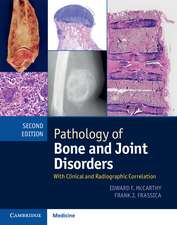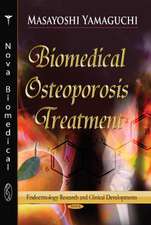Stress and Orality: New Data About Teeth Clenching & Outcomes, Migraine, Fibromyalgia, Fatigue
Autor Francis Hartmann, Gérard Cucchien Limba Engleză Hardback – 16 sep 2013
Are oral disorders only an issue for dentists? The answer is no.
If your patients complain of pain and/or discomfort, if some are diagnosed as suffering from migraines, fibromyalgia or chronic fatigue, and if classical therapies have remained ineffective, this book could help in your daily practice. When it comes to the complex pathology called Temporo-Mandibular Disorders (TMD) most specialists favour a multidisciplinary approach and treatment of socio-psycho-emotional factors as well as dental, lingual or postural disorders. Yet little is known - from a clinical point of view - about a tricky oral spastic habit called severe teeth clenching. In view of the lack of clinical findings from classical investigations on the subject, it could be considered as the “hidden part of an oral parafunctional iceberg”. Neuroscience has been able to shed some light on the multiple connections between trigeminal and non-trigeminal nervous centres, which confirms the significant involvement of the stomatognathic system and trigeminal nerves (V) in both oral as well as non-oral major functions such as eating, breathing, speaking, hearing, and standing … and also confirms the extensive participation of the paired Vs in the human adaptation process. Too many physicians are still reluctant to admit the pathological responsibilities of the Vs. Therefore their role remains largely underestimated by clinicians. Stress conditions in introverted people cause a parafunctional habit (i.e. severe clenching),which in turn produces trigeminal overstimulation and nociception. Through a process of sensitization this can perturb some non-trigeminal nervous areas, such as the vestibular nuclei and cerebellum (involved in equilibrium). Would you then be willing to accept the possibility that a stressed and introverted patient who clenches hard, durably or frequently may end up suffering from dizziness? If not, this book is not for you. But if you accept the scientific data and clinical facts this book will offer a concrete therapeutic protocol: the Relaxing and Moderating Treatment (RMT), which can greatly help you to familiarize yourself with and neutralize this little known deleterious spastic oral parafunction and its many disconcerting pain-causing and dysfunctional clinical effects. Prepare to be amazed by the results, just as we were!
| Toate formatele și edițiile | Preț | Express |
|---|---|---|
| Paperback (1) | 895.58 lei 39-44 zile | |
| Springer – 23 aug 2016 | 895.58 lei 39-44 zile | |
| Hardback (1) | 725.42 lei 3-5 săpt. | |
| Springer – 16 sep 2013 | 725.42 lei 3-5 săpt. |
Preț: 725.42 lei
Preț vechi: 763.60 lei
-5% Nou
Puncte Express: 1088
Preț estimativ în valută:
138.81€ • 145.22$ • 115.31£
138.81€ • 145.22$ • 115.31£
Carte disponibilă
Livrare economică 13-27 martie
Preluare comenzi: 021 569.72.76
Specificații
ISBN-13: 9782817802701
ISBN-10: 2817802705
Pagini: 144
Ilustrații: XII, 300 p. 213 illus., 212 illus. in color.
Dimensiuni: 155 x 235 x 19 mm
Greutate: 0.66 kg
Ediția:2014
Editura: Springer
Colecția Springer
Locul publicării:Paris, France
ISBN-10: 2817802705
Pagini: 144
Ilustrații: XII, 300 p. 213 illus., 212 illus. in color.
Dimensiuni: 155 x 235 x 19 mm
Greutate: 0.66 kg
Ediția:2014
Editura: Springer
Colecția Springer
Locul publicării:Paris, France
Public țintă
Professional/practitionerCuprins
Authors’ foreword.- General Introduction.- Diagnosis.- Introduction.- Symptoms Pain Location.- Nature, aggravating or relieving factors.- Resistance to drugs.- Discomforts.- Auditory problems.- Problems with swallowing and phonation.- Problems with posture and vision.- Fatigue and sleeping disorders.- Psychological mood disorders.- Prolonged unexplained fever.- Immuno-deficiency disorders.- Autonomic problems.- Problems with nutrition.- Objective signs.- Examination.- Extraoral examination.- Intraoral examination.- Palpation.- Extraoral palpation.- Intraoral palpation.- Listening.- Acute factors.- Stomatognathic parafunctions.- Pathophysiology.- Characteristics of periodontal proprioception.- Physiological receptors.- The trigeminal nerve pathways and their central projections.- The long ascending trigemino-telencephalic projection pathways.- The long ascending trigemino-cerebellar projection pathways.- The outside-TBNC trigeminal projections.- Useful physiological reminders.- The sensitivo-motor innervation of the skeletal muscle.- The rest position of the jaw.- Inhibition Reflex of the Jaw Closing Muscles Originating in the Periodontum (IRJCMOP).- Phasic activity of the stomatognathic muscles.- The brain control on muscular activities.- Other implicated nervous centres.- Pathophysiological conditions.- Stomatognathic muscular spasticity.- Oral parafunctions.- Familiar grinding.- Clenching : a misunderstood condition.- Theory of sensitization in the low neural pathways.- Theory of the “high association pathways”.- The behavioral side of clenching.- Biochemical data.- Serotonine.- Dopamine.- Substance P.-Acetylcholine.- Others.- Painful outcomes of parafunctional clenching.- Discomfort as the outcome of parafunctional clenching.- Auditory problems.- Problems with swallowing and phonation.- Problems with posture and vision.- Fatigue.- Sleeping disturbances.- Prolonged unexplained fever.- Immunodeficiency problems.- Autonomic problems.- Problems with memory.- Problems with nutrition.- The Relaxing and Moderating Treatment (RMT).- Local procedures.- Clenching self-control: the “lips-technique”.- Drug prescription.- General relaxation and psychotherapy.
Notă biografică
Francis Hartmann is Honorary professor at Odontology Faculty, Université de la Méditerranée Aix-Marseille, Past président of Collège National de Biologie Buccale, Marseille, France. Gérard Cucchi is Doctor in odontological sciences, hospital and university assistant.
Caracteristici
Approach results both from personal clinical observation about pain and dysfunctions of the oral sphere and international bibliographic fundamental study (especially in neurosciences) Description of some coherent models to explain the little known links between the oral sphere and the rest of the body Book in a very simple, acceptable and useful form for practitioners in the aim to give some help in their daily clinical cares Includes supplementary material: sn.pub/extras











